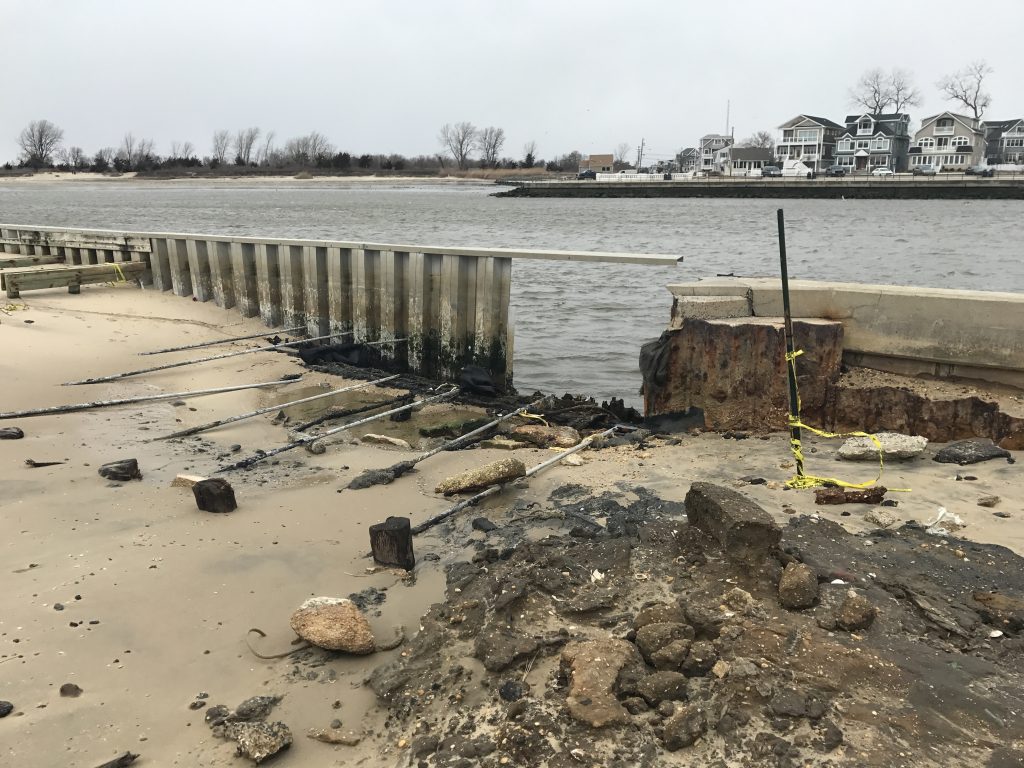As sunshine descended into a cloudy end of the day Sunday, “the wall” along the south side of Manasquan Inlet in Point Pleasant Beach was still packed with anglers hoping to score one last bite of the weekend.
The fishing didn’t disappoint, with a keeper fluke and a throwback striped bass hooked from the depths of the inlet just before dark. Things were muddy, however, and rain from storms this week still pooled in some areas along the wall. While far from the worst condition it’s ever been in, moving waves from this winter’s storms that broke above the wall have carved out a path of erosion, beginning to undermine the concrete.
For officials in Point Pleasant Beach, the problem is one that has plagued the borough for decades. While it is a time-honored tradition among Shore locals to “check out the inlet” during nor’easters and other storms, it’s as much of a tradition for police officers to have to block access when water fills the entire gulf between the parking area and the sea wall – and for public works crews to be left with the arduous task of removing all of the gravel, sand, mud and sea weed that finds its way into the large parking area and along Inlet Drive. Then there’s the seemingly bi-annual cost of rebuilding the sandy area near the wall by trucking in loads of sand and gravel, with the expectation that the job will eventually have to be done all over again.
|
|
“All of the stones and gravel along the sea wall get thrown into the parking lot or washed away,” said Point Pleasant Beach Mayor Paul Kanitra. “It takes man-hours to sweep it back, and money to replace the fill every couple of years. So we’ve put aside some money to develop a more permanent solution along the inlet.”
Last week, the Point Pleasant Beach borough council authorized an engineering firm to design what it calls the Inlet Access Improvement Project, which will see a plan put together that will minimize the erosion, flooding and resulting mess that develops after coastal storms.
The details are still yet to be worked out – hence hiring the engineering firm to develop a comprehensive plan – but there are some ideas that have already been discussed. Kanitra said the town has applied for grant funding that would bring what are known as “bioswales” to the inlet.
Growing in popularity in recent years, bioswales are essentially small channels that run above above and below ground to direct storm water into a recharge system or, in the case of the inlet, back to its source. Bioswale systems, which are built at an angle of about 6 degrees to collect water, are usually accompanied by check dams, which counteract erosion by reducing the velocity of the water flowing through the system. The bioswales are normally covered with vegetation or other natural features to assist with drainage and improve their aesthetics.
Kanitra said such a system at “the wall” along the inlet would not impede access to fishing.
“It will allow fishing to still happen, while still having the right kind of barrier,” he said.
Other aspects of the inlet improvement program could consist of concrete improvements and engineering components that would lessen the amount of debris that would spill onto streets and undermine the sea wall in storms.
“We might be able to re-do the parking lot, and it could be some sort of concrete or drainable walkway along the sea wall that still allows for proper drainage,” said Kanitra.
Point Beach officials committed up to $33,000 for the design of the drainage improvement system. Officials there also included the project in a 2021 bonding measure.

Advertisement

Police, Fire & Courts
Grand Jury Indicts Point Pleasant Man, Once a Fugitive, for Attempted Murder









